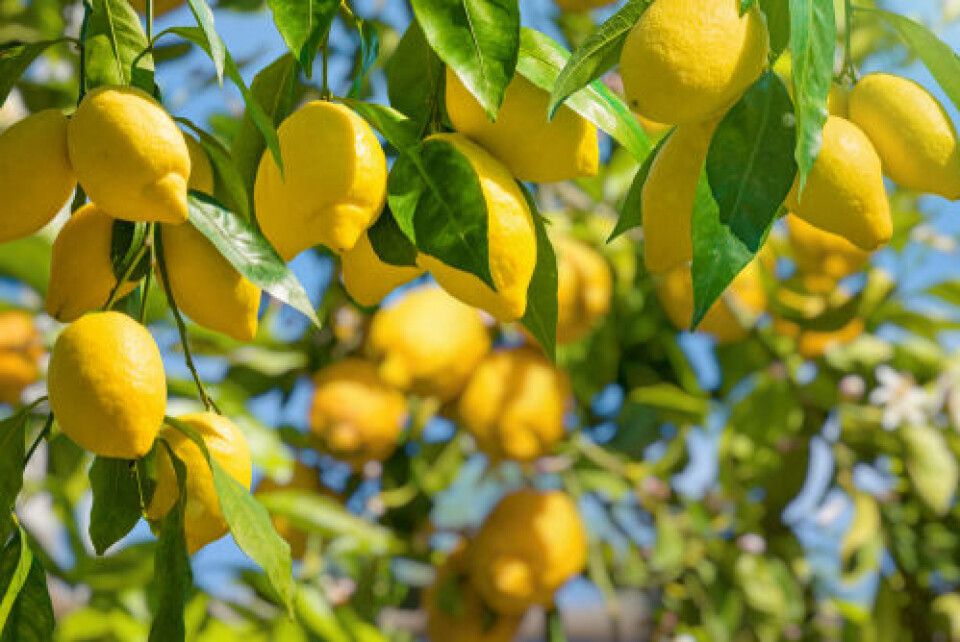-
Which is the cheapest supermarket in France?
A new study shows just how close prices for common food items can be across brands
-
Did you know? France invented the strawberry
As strawberry season gets underway, you might be surprised to hear that garden strawberries originated in France and can be used in many ways
-
Sweet and flavoursome: France’s strawberry season starts now
The first gariguettes are already being picked in south-west France. Supermarket prices are around €3.99 a 250g punnet
My tips for successfully growing lemons in France
We looks at the citrus fruit’s origins and offers cultivation tips

My little containerised lemon suddenly provided me with a little pot-gardening zest in the summer last year.
We’d had lemons for sure and some lovely blossom over a three-year period, but the plant foliage was droopy and it appeared to be simply struggling through life.
Suddenly I changed its routine and it seemed to visibly sigh with relief and begin to produce little red-tinged bunches of fresh foliage at the tips of the stems.
The difference came with the purchase of a citrus fertiliser, which claimed that I would see ‘résultats visible en sept jours’.
Well, it may not have been a week, but it was fast. I really am not sure why.
The nitrogen/phosphorus/potassium (NPK) balance was 8-5-5, which indicates an elevated nitrogen level.
This, say some manufacturers, is essential for good foliage growth to carry a healthy crop.
Others say a balanced NPK is best for citrus. Perhaps it is hidden (unlisted) micronutrients that do their splendid work?
Whatever... I am now a believer.
Pot-grown citrus plants grow winter
Since pot-grown citrus plants continue to grow throughout the winter, you can happily continue fertilising in the colder weather.
There’s a ‘but’: the fastest way to kill a pot-grown citrus plant in winter is to over-water it, so you’ll need to allow it to dry out a bit between waterings.
Which means, of course, that the plant will take up less fertiliser. Fertiliser aside, in March it’s definitely time for a citrus kickstart.
Either top-dress – scraping off the top four to six centimetres of compost and replacing it with fresh – or repot the plant entirely, using a pot that’s only one size up from the existing.
Crucially, keep in mind that citrus fruits will appreciate an ericaceous compost or one custom-made for them.
Don’t overdo the repotting
Above all, don’t overdo the repotting because they like to be a little pot-bound.
Citrus fruits are fascinating for their globe-trotting origins.
Although we associate them with the Mediterranean region, it is believed that the lemon (Citrus limon) was first brought to Italy from Assam, in India, during the second century AD by soldiers of the Roman Empire.
It is thought to be a naturally occurring hybrid between bitter orange (Citrus aurantium) and a tree with large, rough fruits resembling a lemon, called called citron or ‘cedrate’ (Citrus medica).
Our modern ‘citronniers’ are mostly of the ‘Four Seasons Lemon’ type, of which ‘Eureka’ is the most widely grown globally.
It is to this group that my own little plant belongs.
They are ‘four seasons’, because if you cater correctly to their needs, you can get your plant to carry a crop at various stages of maturity – from flowers to ripe fruit.
Cultivars from the group of ‘Amalfi’ lemons come highly recommended, particular ‘Lunario’, an old Italian cultivar.
Apparently, the fabled Meyer’s lemon, with a thin rind and very sweet flavour, can be difficult to overwinter (presumably because it’s a fussy drinker), so is best avoided if you are a beginner.
It is believed to be a natural cross between Citrus limon and sweet orange (Citrus sinensis).
Frost sensitive
The vast majority of our favourite citrus – the ‘Four Seasons Lemon’ included – are frost sensitive and demand winter minimums of not lower than about 5°C (10°C is ideal).
So, they make good glasshouse subjects, although they are mostly intolerant of the dry conditions in the living quarters of your home and therefore do not excel on windowsills.
The calamondin orange (Citrus madurensis) seems to be the exception, accepting more the more arid atmosphere of the home, with the accompanying characteristic that it will not tolerate a temperature that sinks much below 13°C.
Thought to be a natural hybrid between a Kumquat and an acid mandarin, it makes excellent marmalade on top of being a very attractive house plant.
If you want to try a hardier citrus plant in the open garden, there is a wider choice than you might think.
Try a Yuzu or the Eremorange, both of which are hardy from -12°C (and more, in the case of the Yuzu).
The fruit of each of these types is harvested in the autumn, around October/November, and so will not be spoilt by low temperatures.
The Yuzu (Citrus junos), is a naturally occurring Japanese hybrid between the Ichang Papeda (a Chinese citrus, C. cavaleriei) and the Satsuma mandarin.
The chef’s choice in Asian cooking
It’s the chef’s choice in Asian cooking, for the way in which its tartness is retained even at high temperatures.
The highly aromatic fruit is slightly smaller than a billiard ball, with lots of seeds and little juice. Eremorange (C. glauca x C. sinensis), from Australia, is thought to be a hybrid between the Australian lime and a sweet orange, occurring naturally in the dry outback.
Aside from its hardiness, it is remarkable for a great tolerance of drought conditions and works as an excellent marmalade fruit.
If you want to have a go at citrus growing, do your research.
There are more varieties and hybrids available every day, with something for every taste, but beginners could do worse than starting with the easiest, such as a Four Seasons lemon like ‘Eureka’ and the Calamondin orange.
Related articles
Tannins can make red wine undrinkable or delicious – what are they?
Gardening in France: Dianthus or pinks are a classic passalong cutting
France’s Carpentras strawberry crops bring juicy joy
























